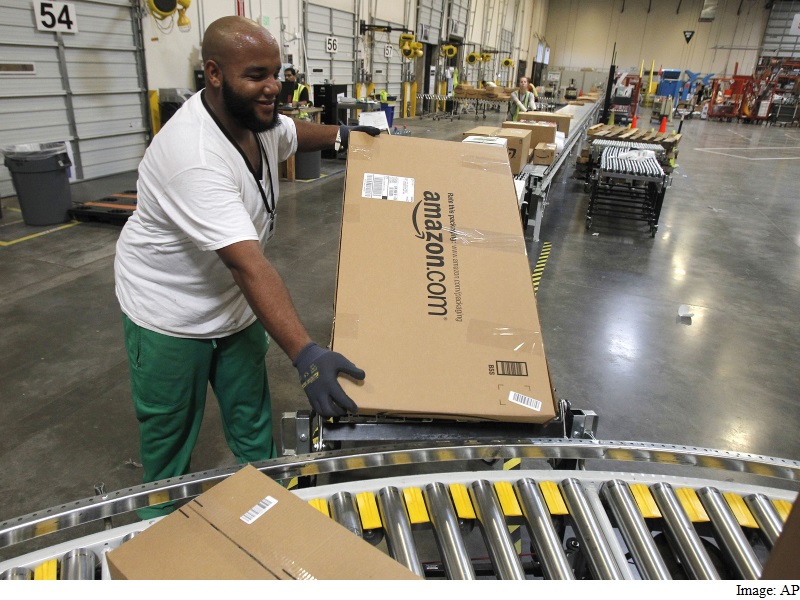- Home
- Internet
- Internet News
- Amazon Flex: Retailer's Uber Like Effort to Bring You Packages
Amazon Flex: Retailer's Uber-Like Effort to Bring You Packages

With Amazon Flex, the company says, drivers can make from $18 to $25 an hour ferrying packages to customers that were ordered as part of its one-hour Prime Now delivery service. As with on-demand car services such as Uber and Lyft, drivers will be independent contractors who select their own work hours.
The new approach is part of the retailer's ongoing obsession with getting items to customers faster, and could help reduce Amazon's dependency on major shipping carriers such as UPS and FedEx. And with Uber also experimenting with using its network for deliveries, it could also put these two big names in the tech sector in direct competition.
"They are more and more starting to confirm for themselves that for them to be such a big online retailer, having some capabilities of their own [for] distribution is a core competency, and not an outsourced one," Satish Jindel, president of logistics advisory firm SJ Consulting Group, said of Amazon.
But Flex also could ensnare Amazon in many of the wage and policy debates that Uber has faced as it has expanded rapidly across the country. There has been a flurry of legal battles over whether such on-demand drivers should be considered employees instead of independent contractors, and labor groups have criticized companies such as Uber, Instacart and others with similar business models for not giving these contractors benefits and other perks.
Amazon Flex is already active in Seattle and will soon be coming to other cities where Amazon's Prime Now program is offered, including Baltimore, New York, Miami, Dallas, Austin, Chicago and Atlanta. On its Web page about Flex, Amazon says that, along with delivering Prime Now orders, Flex drivers may someday deliver other types of Amazon orders, too.
Amazon frequently tests unconventional ways to get packages to customers. In April, Audi announced that it was testing an offering in Germany in which shoppers could have Amazon boxes delivered directly to their car trunks, and the Wall Street Journal has reported that Amazon tested a bike delivery service in Manhattan. Plus, the e-commerce company is famously experimenting with drone delivery.
Sucharita Mulpuru, an e-commerce analyst at Forrester Research, said she is skeptical that Amazon Flex will viable, since shoppers have again and again proven they hate to pay for shipping, and merchants might not be crazy about paying for this speedy delivery, either.
"That leaves Amazon subsidizing it, similar to what Instacart and the other delivery startups are doing," Mulpuru said in an e-mail. "That doesn't make for profitable transactions or loyal customers."
Jindel said that the key to making Flex sustainable will be building density. If each driver is being paid about $20 per hour, he reasons, five deliveries in an hour could get costs for Amazon down to $4 per package, a good price. But if a courier only delivers one package in an hour, the price no longer looks so good.
Overall, Jindel estimates that Amazon ships 4.5 million packages a day, about half of the volume that FedEx Ground does in a given day.
Amazon says Flex drivers will need to pass a background check and must be 21 years old. They also must have an Android phone, a sign that its app for drivers likely only works (or works best) on these devices. The company promises on its Web site that Flex drivers will be able to get "consistent work," as deliveries take place seven days a week.
Amazon chief executive Jeffrey Bezos owns The Washington Post.
© 2015 The Washington Post
Get your daily dose of tech news, reviews, and insights, in under 80 characters on Gadgets 360 Turbo. Connect with fellow tech lovers on our Forum. Follow us on X, Facebook, WhatsApp, Threads and Google News for instant updates. Catch all the action on our YouTube channel.
Related Stories
- Samsung Galaxy Unpacked 2025
- ChatGPT
- Redmi Note 14 Pro+
- iPhone 16
- Apple Vision Pro
- Oneplus 12
- OnePlus Nord CE 3 Lite 5G
- iPhone 13
- Xiaomi 14 Pro
- Oppo Find N3
- Tecno Spark Go (2023)
- Realme V30
- Best Phones Under 25000
- Samsung Galaxy S24 Series
- Cryptocurrency
- iQoo 12
- Samsung Galaxy S24 Ultra
- Giottus
- Samsung Galaxy Z Flip 5
- Apple 'Scary Fast'
- Housefull 5
- GoPro Hero 12 Black Review
- Invincible Season 2
- JioGlass
- HD Ready TV
- Laptop Under 50000
- Smartwatch Under 10000
- Latest Mobile Phones
- Compare Phones
- OnePlus 15R
- Realme Narzo 90x 5G
- Realme Narzo 90 5G
- Vivo S50 Pro Mini
- Vivo S50
- OPPO Reno 15c
- Redmi Note 15 5G
- Redmi Note 15 Pro 5G
- Asus ProArt P16
- MacBook Pro 14-inch (M5, 2025)
- Infinix Xpad Edge
- OnePlus Pad Go 2
- Just Corseca Skywatch Pro
- Honor Watch X5
- Acerpure Nitro Z Series 100-inch QLED TV
- Samsung 43 Inch LED Ultra HD (4K) Smart TV (UA43UE81AFULXL)
- Asus ROG Ally
- Nintendo Switch Lite
- Haier 1.6 Ton 5 Star Inverter Split AC (HSU19G-MZAID5BN-INV)
- Haier 1.6 Ton 5 Star Inverter Split AC (HSU19G-MZAIM5BN-INV)

















